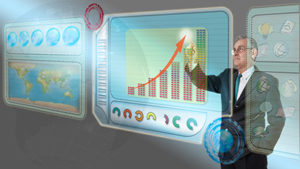
‘Climbing’ Big Data With Virtual Reality

(SuriyaPhoto/Shutterstock)
Thanks to virtual reality technology, analysts can now “climb” big data.
So says business intelligence platform vendor Looker, which claimed to take big data to new heights with a virtual reality app for exploring data as well as how businesses “interact with their data.”
The new platform, dubbed LookVR, was originally designed to merely demonstrate the capabilities of the Looker platform. Project engineers soon realized the tool offered a new way to explore data. “We don’t know if this foretells the future of data visualization or not, but it’s certainly pretty cool,” opined Wil Gieseler, Looker’s product engineer and creator of LookVR.
Looker, Santa Cruz, Calif., argues that virtual reality technology can be leveraged to free data from dashboards, making it easier to search for and share relevant insights. The platform is based on the company’s architecture along with a virtual reality API.
The LookVR API is available now.
Other startups have attempted with limited success to combine analytics and virtual reality tools to enhance big data visualizations. Space-Time Insight, a Silicon Valley company specializing in “situation intelligence,” released the Oculus Rift virtual reality headset in 2015 designed to make sense of large data sets with spatial and temporal attributes. Results are displayed on interactive maps such as Google Earth.
LookVR stems from a company “hack day” when Looker developers were challenged to come up with out-of-the-box concepts. The result was applying the Looker API to experiment with data visualization using virtual reality.
“People have been experimenting with virtual reality a lot over the years, but until the latest round of headsets (the HTC Vive and Oculus Rift) it’s always felt like a toy,” Gieseler noted in a blog post. “With a great developer community and VR tools built into all the major video game engines, it was really easy to start hacking around on getting Looker connected to a VR application.”
A video of the experiment is available here.
Gieseler noted that many assumptions made by visualization experts often do not apply in the realm of virtual reality. For example, he explained, “on a screen or paper, shadow, lighting, and 3-D effects distract from the meaning of the data and can be misleading,” whereas with virtual reality these characteristics are “critical.”
“Screenshots and videos are still inherently 2-D and won’t really convey how real and physical the experience feels,” he added.
The analytical tool vendor’s traditional products include tools designed to handle all data in Google’s (NASDAQ: GOOG) BigQuery platform rather than extracting subsets of data. The company also touts its tools as being able to leverage BigQuery’s speed in handling the entire database so that results are more widely available.
Recent items:
A Virtual Reality Lens For Big Data Visualization
Looker Rolls New Google BigQuery Tools



























